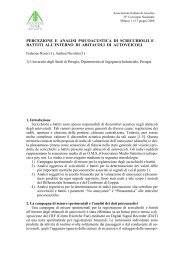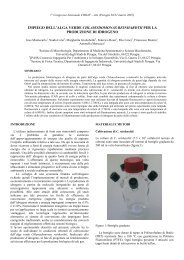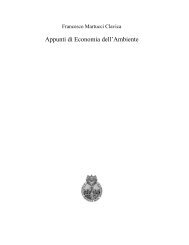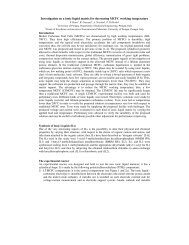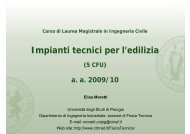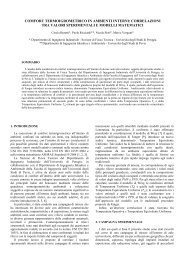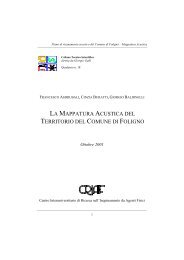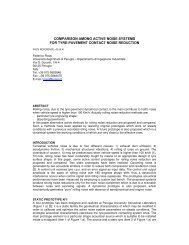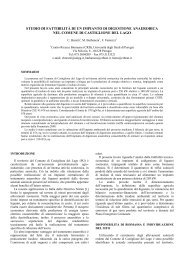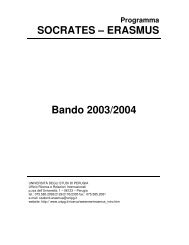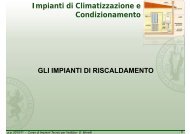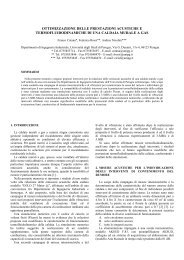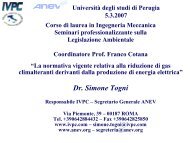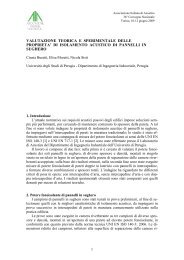il laboratorio per la caratterizzazione energetica delle biomasse del
il laboratorio per la caratterizzazione energetica delle biomasse del
il laboratorio per la caratterizzazione energetica delle biomasse del
Create successful ePaper yourself
Turn your PDF publications into a flip-book with our unique Google optimized e-Paper software.
fine di individuare <strong>la</strong> migliore tecnologia di conversione.Presso <strong>il</strong> Centro Ricerca Biomasse <strong>del</strong>l’Università degliStudi di Perugia è stato realizzato un <strong><strong>la</strong>boratorio</strong> <strong>per</strong> l’analisichimica e fisica <strong>del</strong><strong>la</strong> biomassa dotato di strumentazioni <strong>per</strong> leseguenti analisi: Analisi Prossima, Analisi Ultima, misura <strong>del</strong>PCS e PCI, misura <strong>del</strong><strong>la</strong> durab<strong>il</strong>ità <strong>del</strong> pellet.I campioni analizzati nel Laboratorio <strong>del</strong> CRBappartengono a differenti categorie di biomassa, ma quelle ditipo legnoso sono sicuramente le più numerose e neldocumento ne sono stati riportati alcuni risultati. Tali valorisono poi stati confrontati con dati re<strong>per</strong>iti in Letteratura,dimostrando l’affidab<strong>il</strong>ità dei risultati ottenuti.Tutti i dati frutto <strong><strong>del</strong>le</strong> analisi vengono archiviati in unabanca dati e<strong>la</strong>borata dallo staff <strong>del</strong> CRB.NOMENCLATURACRB: Centro di Ricerca sulle Biomasse;wb: wet basis, base umida;db: dry basis, base secca;daf: dry ash free, base secca e priva di ceneri;FC: Fixed Carbon, Carbonio Fisso (%);PCS: Potere Calorifico Su<strong>per</strong>iore o HHV (MJ/kg);PCI: Potere Calorifico Inferiore o LHV (MJ/kg);RSD: Re<strong>la</strong>tive Standard Deviation.RIFERIMENTI BIBLIOGRAFICI[1] CENT/TS 14778-1: Solid Biofuels – Sampling–Part 1:Methods for sampling, (2004).[2] CENT/TS 14779 : Solid Biofuels – Sampling – Methodsfor preparing sampling p<strong>la</strong>ns and sampling certificates,(2004).[3] CENT/TS 14780: Solid Biofuels – Methods for samplepreparation, (2004).[4] UNI 9903-3: Combustib<strong>il</strong>i solidi non minerali ricavatida rifiuti (RDF). Indicazioni di base <strong>per</strong> <strong>il</strong>campionamento sistematico dei combustib<strong>il</strong>i (inItalian), (1992).[5] CENT/TS 14774-1: Solid Biofuels - Methods fordetermination of moisture content - Oven dry method.Part 1: Total moisture - Reference method, (2004).[6] CENT/TS 14774-2: Solid Biofuels - Methods fordetermination of moisture content- Oven dry method.Part 2: Total moisture - Simplified method, (2004).[7] CENT/TS 14774-3: Solid Biofuels -Methods fordetermination of moisture content-Oven dry method.Part 3: Moisture in general analysis sample, (2004).[8] CENT/TS 14775: Solid Biofuels – Methods fordetermination of ash content, (2004).[9] UNI 9903-8: Combustib<strong>il</strong>i solidi non minerali ricavatida rifiuti (RDF). Determinazione <strong><strong>del</strong>le</strong> sostanzevo<strong>la</strong>t<strong>il</strong>i. (in Italian), (1992).[10] ASTM D5373: Standard test method for instrumentaldetermination of carbon, hydrogen, and nitrogen in<strong>la</strong>boratory sample of coal and coke, (2002).[11] UNI 9017: Legno da ardere – Determinazione <strong><strong>del</strong>le</strong>caratteristiche energetiche (in Italian), (1987).[12] CEN TC 335 WG 4: Draft test method, (2003).[13] L. Cuiping, W. Chuangzhi, H. Haitao, Chemicalelemental characteristics of biomass fuels in China,Biomass and Bioenergy, 27 (2004) 119-130.[14] M. Ohman, C. Boman, H. Hedman, A. Nordin, D.Bostrom, , S<strong>la</strong>gging tendencies of wood pellet ashduring combustion in residential pellet burners,Biomass and Bioenergy, 27 (2004) 585–596.SUMMARYThe use of renewable energy sources is becoming importantto reduce global warming and to provide fuel supply. Biomassfuels have to be used in a clean and more efficient way; it istherefore important to know their chemical and physicalcharacteristics, in order to choose the best energy conversionprocess.The Biomass Research Centre of University of Perugia,realized a <strong>la</strong>boratory to study physical and chemicalcharacteristics of biomass and to bu<strong>il</strong>d a database, on ultimateanalysis, proximate analysis and lower calorific value, incompliance with Italian Standard UNI, European CEN/TS andAmerican Technical Norms ASTM. The main samplesanalyzed are residual and forestry biomass, collected fromUmbria Region, and solid biofuels such as pellets and chips.Archive and ex<strong>per</strong>imental data are <strong>per</strong>iodically updated andincreased in number.



